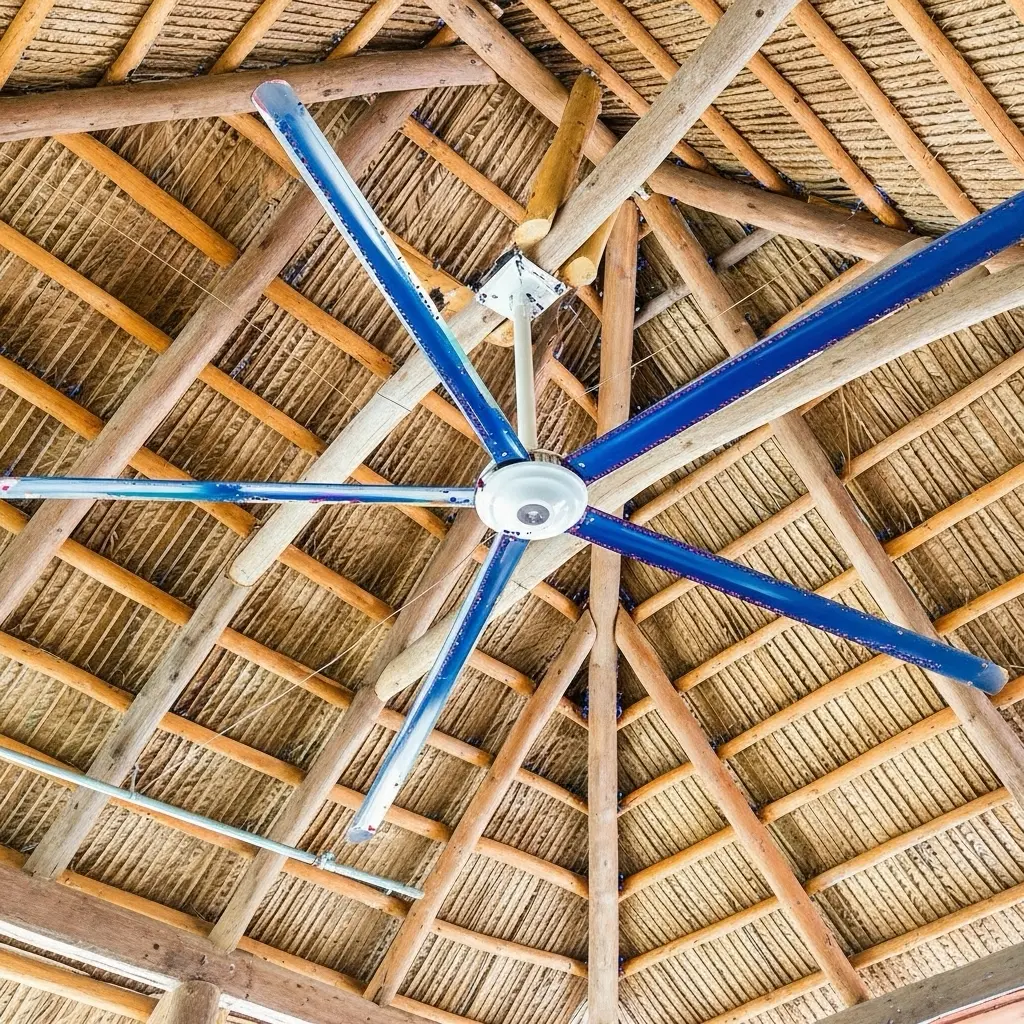Discover how a high volume low speed fan (HVLS fan) improves comfort, saves energy, and transforms airflow in large spaces complete with brand comparisons and installation tips.
High Volume Low Speed (HVLS) fans have redefined the way industrial and commercial buildings manage air circulation. These giant, slow-moving ceiling fans deliver massive airflow coverage while consuming minimal energy. From warehouses and gyms to agricultural barns and event centers, HVLS technology combines elegant engineering with measurable energy efficiency making it a staple for modern climate control systems.
Table of Contents
Understanding the Concept: What Is a High Volume Low Speed Fan?
Unlike ordinary ceiling fans that spin quickly and move small amounts of air, a high volume low speed fan moves air slowly over enormous areas. Diameters typically range from 8 to 30 feet, and the fan rotates between 40–70 RPM. As the blades turn, they push air downward to form a large column that spreads horizontally once it reaches the floor creating a uniform “floor jet” that covers thousands of square feet.
According to Big Ass Fans, one HVLS fan can replace 20 or more small high-speed fans while delivering better comfort and using less power. The result: gentle, silent airflow that keeps workers cool in summer and reduces heating costs in winter.
The Physics Behind HVLS Airflow
Airflow in HVLS systems relies on three principles:
- Displacement Volume: Large blades displace massive volumes of air at low pressure, enabling smoother circulation with less turbulence.
- Destratification: Warm air naturally rises to the ceiling; HVLS fans mix these layers, equalizing temperatures between floor and ceiling—reducing heating energy by up to 25 %.
- Convection & Evaporative Cooling: The slow, consistent breeze accelerates evaporation from skin and surfaces, producing a 5–10 °F drop in perceived temperature without lowering actual air temperature.
Figure 1 – Placeholder for Airflow Diagram: Depict air column descending and spreading horizontally across the floor to illustrate “floor jet” effect and destratification loop.
Key Benefits of High Volume Low Speed Fans
1. Energy Efficiency and Cost Savings
Because HVLS fans use efficient direct-drive or EC motors, they consume 60–80 % less electricity than multiple small fans combined. When integrated with HVAC systems, they can reduce overall energy consumption by 20–30 %. A single 24-foot fan covering 20 000 sq ft typically draws 0.75 kW—equivalent to only 10 ¢ per hour at average North American rates.
2. Comfort and Productivity Improvement
Facilities with consistent airflow report lower absenteeism and greater productivity. Marut Air notes that even a gentle air speed of 2–3 ft/s can make workers feel 4–6 °F cooler, helping mitigate heat stress in warehouses and agricultural facilities.
3. Health and Air Quality
Continuous circulation reduces moisture and mold buildup, dilutes airborne contaminants, and enhances fresh-air mixing. This benefit is especially important in food processing and livestock facilities subject to ventilation standards.
4. Quiet Operation and Low Maintenance
Modern HVLS fans operate at less than 55 dB—quieter than normal conversation. Direct-drive motors eliminate gearboxes and reduce wear, resulting in service intervals measured in years instead of months.
Performance Comparison by Brand
| Manufacturer | Typical Diameter (ft) | Airflow (CFM) | Power Draw (kW) | Efficiency (CFM/W) | Noise Level (dB) |
|---|---|---|---|---|---|
| Big Ass Fans – Powerfoil X3.0 | 24 | 395 000 | 0.78 | 506 | 52 |
| MacroAir – AirVolution D | 20 | 300 000 | 0.65 | 462 | 50 |
| Hunter Industrial – Titan Series | 24 | 375 000 | 0.72 | 520 | 53 |
| Marut Air – HVLS Elite | 18 | 220 000 | 0.50 | 440 | 54 |
Table 1 – Performance comparison of leading HVLS brands based on manufacturer data.
Applications and Sizing Guidelines
- Warehouses: Use one 24 ft fan per 20 000–25 000 sq ft with ceilings above 25 ft.
- Gyms & Sports Centers: Ideal diameters 18–20 ft to maintain 2–3 ft/s air velocity without drafts.
- Livestock Barns: Install fans 18–24 ft wide for gentle airflow over animals to reduce heat stress.
- Manufacturing Plants: Combine multiple fans spaced 60–100 ft apart to overcome machinery obstructions.
Figure 2 – Placeholder for Coverage Map: Diagram showing fan coverage zones and overlap patterns for optimal airflow distribution.
Installation and Placement Best Practices
- Ensure mounting structure can support 150 lb load plus dynamic forces. Hunter Industrial recommends 1.5× safety factor for steel I-beams.
- Maintain at least 2 ft clearance above the fan and 10 ft below the blades.
- Space fans 60–120 ft apart for even coverage as outlined in Hunter’s Placement Guide.
- Use professional installers for electrical wiring and balancing to comply with CEC and NEC standards.
Energy and Cost Model Example (Canada 2025)
| Scenario | Space Size (sq ft) | Fans Required | Total Power (kW) | Monthly Cost (CAD @ $0.13/kWh) | Annual Savings vs AC-Only |
|---|---|---|---|---|---|
| Warehouse | 40 000 | 2 × 24 ft | 1.5 | $17.55 | $1 200+ |
| Gymnasium | 10 000 | 1 × 20 ft | 0.6 | $7.02 | $480+ |
| Agricultural Barn | 25 000 | 1 × 22 ft | 0.7 | $8.19 | $600+ |
Table 2 – Operating cost and energy savings for HVLS fans in typical Canadian applications.
Integration with HVAC and Smart Controls
Modern HVLS fans include smart controllers that automatically adjust speed based on temperature or humidity sensors. Integration with Building Management Systems (BMS) or IoT platforms like BACnet and Modbus enables central monitoring. This adaptive control further improves efficiency by avoiding over-ventilation or excess cooling.
Canadian Climate Advantages and Rebates
In Quebec and Ontario, utilities such as Hydro-Québec and IESO offer rebates for installing energy-saving ventilation equipment under commercial retrofit programs. Because HVLS fans reduce heating and cooling loads, they often qualify for these incentives when properly documented with energy audits.
Maintenance Best Practices
- Clean blades every 6 months using a non-abrasive cloth and mild detergent.
- Inspect mounting bolts annually for torque per manufacturer specs (typically 20 ft-lb).
- Check electrical connections for tightness and ensure controller firmware updates are applied.
- Record service dates for warranty validation (10–15 years for most motors).
Environmental Impact
Each HVLS fan reduces CO₂ emissions by approximately 3 tons per year compared to equivalent HVAC usage for the same comfort level. Over a 10-year lifespan, this equals removing 60 passenger vehicles worth of emissions from the road.
FAQs About High Volume Low Speed Fans
- Q: What size HVLS fan do I need for my warehouse?
A: Use 1 × 24 ft fan per 20 000 sq ft or multiple smaller units to cover irregular layouts. - Q: Can HVLS fans replace air conditioning?
A: They don’t lower air temperature but can reduce HVAC load by 30 %, allowing higher thermostat settings. - Q: Are they noisy?
A: No, most operate between 45 and 55 dB, quieter than a conversation. - Q: Do HVLS fans work in cold climates?
A: Yes, they push warm air down from ceilings to reduce heating costs in winter. - Q: How long do they last?
A: With minimal maintenance, HVLS fans often last 15–20 years in commercial use.
Conclusion
A high volume low speed fan is not just a piece of equipment—it’s a strategic investment in energy efficiency, comfort, and air quality. By leveraging the principles of destratification and gentle air movement, HVLS fans deliver year-round benefits for industrial and commercial spaces. Whether you’re modernizing a warehouse in Mont

